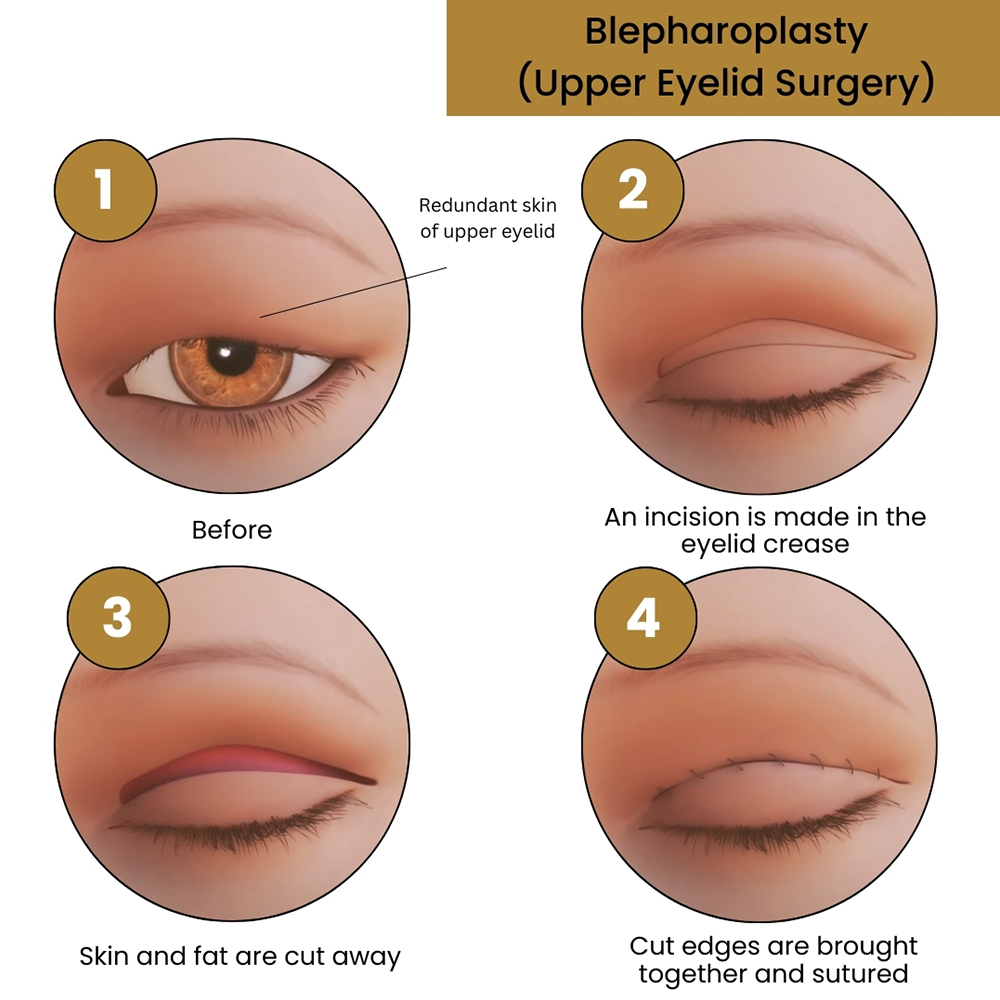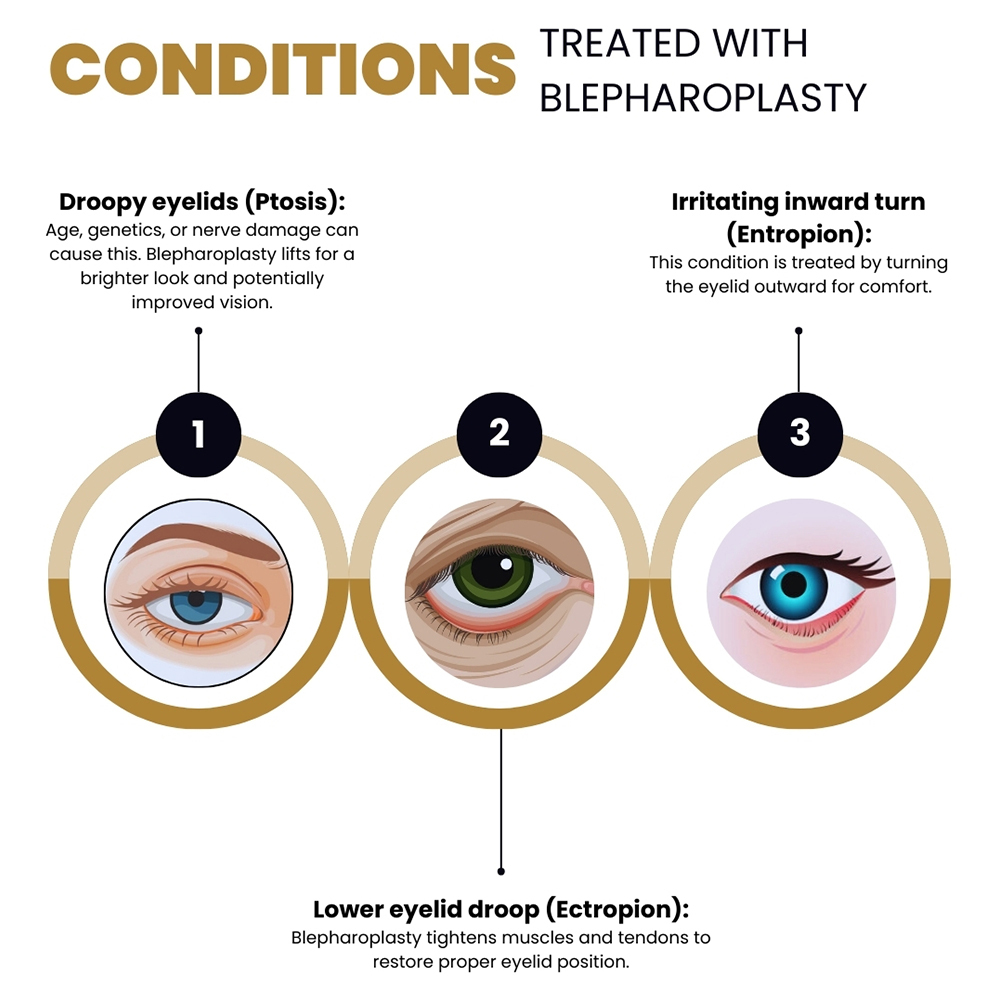Why Might I Need Blepharoplasty?
Excess skin sometimes gathers above or below your eyes as you age, which may give you a tired appearance and even affect your eyesight. Blepharoplasty is a surgical procedure in which excess skin is removed or tightened in your eyelids. You can get eyelid surgery for your upper eyelids, lower eyelids or both. And you can combine this procedure with other procedures, such as laser resurfacing, a face lift or a brow lift.
When you’re looking for a knowledgeable and reputable plastic surgeon in New York City, look no further than Millennial Plastic Surgery. Dr. David Shokrian and his experienced cosmetic surgery team have years of experience performing eyelid surgery and the other procedures designed to improve the appearance of your face and body.

What Does Blepharoplasty Treat?
There are several factor that may lead you to consider a blepharoplasty procedure. Sagging skin around your upper eyelids can create an unnatural fold, while lower eyelids that droop may show the whites of your eyes under the iris.
Conditions treated with blepharoplasty include:
- Ptosis. Ptosis is the medical term for drooping eyelids. Eyelids may droop for genetic reasons, as part of the aging process or because of nerve damage to the muscle that controls the eyelid.
- Entropion. This is a condition in which the eyelid turns inward, which may cause irritation to the eyeball. This usually occurs in the lower eyelid. Treatment of this condition turns your eyelid outward while tightening the skin around it.
- Ectropion. Aging can cause the lower eyelid to droop away from the eye. Eyelid surgery can tighten the muscles and tendons of your lower eyelid to correct this issue.
Sagging eyelids, excess skin or bags under your eyes may make you self-conscious about your appearance. In some cases, droopy eyelids affect your vision, particularly your peripheral vision. This type of surgery isn’t done to drastically change your appearance, but to help you look younger and more naturally rested.

What Are the Different Types of Blepharoplasties?
There are a few different types of blepharoplasty procedures. All blepharoplasties are outpatient surgeries. The procedure that’s right for you depends on your specific concerns.
The types of blepharoplasties include:
- Upper eyelid surgery. Puffiness and droopiness of your upper eyelid can be corrected with upper eyelid blepharoplasty. Incisions are made within the natural crease of your eye to tighten muscles remove and excess skin. Then the incision is closed. This procedure typically takes about an hour.
- Lower eyelid surgery. If you’re bothered by baggy lower eyelids, Dr. Shokrian may recommend lower eyelid blepharoplasty. An incision is made on the outer edge of the lower lid to remove excess skin and fat. Once that’s done, the incision is closed. Lower eyelid surgery also takes about an hour.
- Combined blepharoplasty. Also called bilateral or double eyelid surgery, this procedure combines both upper and lower eyelid surgery. Combined blepharoplasty takes about two to three hours.
There are some different techniques your NYC plastic surgeon may use. Surgery may be done using a full incision or a partial incision. A partial incision leads to reduced discomfort and minimal scarring while a full incision gives your surgeon a better ability to modify and enhance your eyelids.
Your cosmetic surgeon may give you a choice between anesthesia options for the procedure. Some people prefer general anesthesia, so they sleep through the procedure, while others prefer local anesthesia only. Your New York City surgeon explains your options before the procedure so you can decide together which is the best choice for you.
What Should I Expect during Recovery from a Blepharoplasty Procedure?
After your surgery, gauze is placed on your eyes. You spend a short time in the recovery room, where you’re closely monitored for complications before going home. Plan to stay home and limit your activities for a few days to several weeks to allow your eyelids to heal.
Some things you may experience during your recovery from eyelid surgery include:
- Swelling and bruising
- Blurred vision
- Double vision
- Light sensitivity
- Numb eyelids
Avoid rubbing your eyes. Use ice packs or cold compresses to reduce swelling. Take acetaminophen or ibuprofen if you experience pain. Wear dark sunglasses if you go outside to protect your eyelids from the wind and sun. Closely follow all post-op instructions provided by your NYC doctor, including using any prescription ointments.
Bruising and swelling may take up to 10 days to subside, but once the swelling goes down, most people are very happy with their blepharoplasty results. These eyelid surgeries leave you looking younger and feeling good about your appearance again. Upper eyelid correction can last as long as 10 years, while lower eyelid correction can last a lifetime.
Am I a Good Candidate for Any Type of Blepharoplasty?
Blepharoplasty can be done on both men and women in good health. If you’re bothered by loose saggy skin around the eyes, eye puffiness or drooping eyelids, a blepharoplasty procedure may help you.
The factors that make you a good candidate for this procedure include:
- You have no chronic illnesses, such as heart disease or circulation disorders.
- You have no eye-related medical problems.
- You’re a non-smoker.
- Drooping skin is impairing your vision.
During your consultation, you and your surgeon discuss what you’re hoping to get from the procedure. You must have realistic expectations about what the procedure can do for you — and what it can’t do.
Is There a Non-Surgical Blepharoplasty Alternative?
When signs of eye puffiness or droopiness first appear, you may not feel ready to consider cosmetic surgery.
There are several non-surgical blepharoplasty alternatives offered at Millennial Plastic Surgery to help temporarily, which include:
- Botox
- Dermal fillers
- A combination of injectable fillers and resurfacing
- Radiofrequency microneedling
These alternatives may be effective if you have only mild signs of aging or if you’re not a good candidate for blepharoplasty. Blepharoplasty is considered cosmetic surgery, which means it isn’t usually covered by insurance unless your vision is being affected. The cost of this type of surgery can range from $3,000 to $14,000.
For most adults over 50, however, blepharoplasty is the best solution to eyelid puffiness and drooping. Contact the experts at Millennial Plastic Surgery today for a consultation with Dr. Shokrian, and you can look forward to a rejuvenated appearance.
